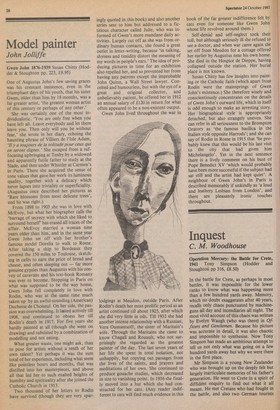Model painter
John Jolliffe
Gwen John 1876-1939 Susan Chitty (Hodder & Stoughton pp. 223, £9.95) One of Augustus John's few saving graces was his constant insistence, even in the triumphant days of his youth, that his sister Gwen, older than him by 18 months, was a far greater artist, 'the greatest woman artist of this century or perhaps of any other.'
She was certainly one of the most individualistic. 'You are only free when you have left all. Leave everybody and let them leave you. Then only will you be without fear,' she wrote in her diary, echoing the haunting phrase of Villiers de 1' Isle Adam, y a toujours de la solitude pour ceux qui en seront dignes.' She escaped from a suffocating upbringing at Tenby by a widowed and apparently futile father to study at the Slade, and then under Whistler at Carmen's in Paris. There she acquired the sense of tone values that gave her work its luminous quality, together with a delicacy which never lapses into triviality or superficiality. (Augustus once described her pictures as 'Rare blossoms from most delicate trees', and he was right.) From 1898 to 1903 she was in love with McEvoy, but what her biographer calls the 'barrage of secrecy with which she liked to surround herself' has erased all traces of the affair. McEvoy married a woman nine years older than him, and in the same year Gwen John set off with her brother's famous model Dorelia to walk to Rome. After taking a ship to Bordeaux they covered the 150 miles to Toulouse, sketching in cafes to earn the price of bread and cheese, and often sleeping out — far more genuine gypsies than Augustus with his convoy of caravans and his text-book Romany was ever to become. Stopping in Paris on what was supposed to be the way home, Gwen John fell completely in love with Rodin, who was at the same time much taken up by an awful-sounding (American) Duchesse de Choiseul. On her side, the passion was overwhelming. It lasted actively till 1908, and continued to obsess her till Rodin's death in 1917. For five years she hardly painted at all (though she went on drawing) and subsisted by a combination of modelling and not eating.
What greater waste, one might ask, than to pose for artists without a tenth of her own talent? Yet perhaps it was the sum total of her experience, including what seem like pointless hours and months, that was distilled into her masterpieces, and above all that led her to such exalted heights of humility and spirituality after she joined the Catholic Church in 1913.
Two thousand of her letters to Rodin have survived (though they are very spar ingly quoted in this book) and also another series sent to him but addressed to a fictitious character called Julie, who was informed of Gwen's more mundane daily activities. Largely cut off as she was from ordinary human contacts, she found a great outlet in letter-writing, because 'in talking, shyness and timidity distort the meaning of my words in people's ears.' The idea of producing pictures in time for an exhibition also repelled her, and so prevented her from having any patrons except the improbable John Quinn, a Wall Street lawyer. Conceited and humourless, but with the eye of a great and original collector, and unbelievably patient, he offered her in 1912 an annual salary of £120 in return for what often appeared to be a non-existent output.
Gwen John lived throughout the war in lodgings at Meudon, outside Paris. After Rodin's death her most prolific period as an artist continued till about 1925, after which she did very little in oils. Till 1932 she had another intense relationship with a Russian, Vera Oumantsoff, the sister of Maritain's wife. Through the Maritains she came to know Chagall and Rouault, who not surprisingly she regarded as the greatest painter of the day. The last seven years of her life she spent in total isolation, not unhappily, but copying out passages from the lives of the saints, and prayers and meditations of her own. She continued to produce gouache studies, which decreased in size to vanishing point. In 1936 she finally moved into a hut which she had constructed for her cats. (Any reader indifferent to cats will find much evidence in this book of the far greater indifference felt by cats even for someone like Gwen John whose life revolved around them.) Self-denial and self-neglect took their toll, but although seriously ill she refused to see a doctor, and when war came again she set off from Meudon for a cottage offered her earlier by Augustus near his own home. She died in the Hospice de Dieppe, having collapsed outside the station. Her burial place is not known.
Susan Chitty has few insights into painting or the Catholic faith (which apart from Rodin were the mainsprings of Gwen John's existence.) She therefore wisely and conscientiously concentrates on the details of Gwen John's outward life, which in itself is odd enough to make an arresting story. Her biographical style is appropriately detached, but also strangely uneven. She can refer in all seriousness to the Brompton Oratory as 'the famous basilica in the Italian style opposite Harrods'; and she can say of Rodin in Rome in 1915 that 'he probably knew that this would be his last visit to the city that had given him Michelangelo'. Yet in the next sentence there is a lively comment on his bust of Pope Benedict XV 'which would probably have been more successful if the subject had sat still and the artist had kept quiet'. A neighbour of Gwen John's in Paris is described memorably if unkindly as 'a loud and leathery Lesbian from London', and there are pleasantly ironic touches throughout.


































 Previous page
Previous page